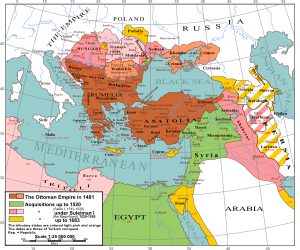Capture of Baghdad (1534)
| Battle of Baghdad (1534) | |||||||||
|---|---|---|---|---|---|---|---|---|---|
| Part of Ottoman–Safavid War (1532–1555) | |||||||||
 Suleiman's conquests in the 1532–55 Ottoman-Safavid war gave him access to the Persian Gulf. |
|||||||||
|
|||||||||
| Belligerents | |||||||||
|
|
|
||||||||
| Commanders and leaders | |||||||||
|
|
|
||||||||
| Strength | |||||||||
| 300 troops still loyal to the Safavids and the city commander | Deserted Safavid troops and army that Suleiman brought in winter to Baghdad | ||||||||
The 1534 capture of Baghdad by Suleiman the Magnificent of the Ottoman Empire from the Safavid dynasty under Tahmasp I was part the Ottoman–Safavid War of 1532 to 1555, itself part a series of Ottoman–Persian Wars. The city was taken without resistance, the Safavid government having fled and leaving the city undefended.Baghdad's capture was a significant achievement given its mastery of the Tigris and Euphrates rivers and their international and regional trade. It represented, along with the fall of Basra in 1546, a significant step towards eventual Ottoman victory and the procurement of the lower Mesopotamia, the mouths of the Euphrates and Tigris rivers, opening a trading outlet into the Persian Gulf. The Ottomans wintered there until 1535, overseeing the reconstruction of Sunni and Shia religious shrines and agricultural irrigation projects. Suleiman returned to Constantinople, leaving a strong garrison force. Over the next few decades, the Ottomans solidified their control of the region, incorporating it into their empire until it was recaptured by the Persians in 1623.
...
Wikipedia
